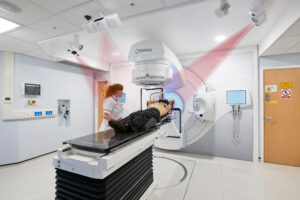 RT(T) Lorna Wood, one of Vision RT’s Clinical Application Specialists, supports cancer centers all around the UK and Ireland, helping them get the most out of AlignRT and Vision RT’s other products. In this blog post, she talks about how she has witnessed clinics create an efficient workflow that not only helps their teams work more efficiently but can also ensure greater accuracy and provide a better patient experience.
RT(T) Lorna Wood, one of Vision RT’s Clinical Application Specialists, supports cancer centers all around the UK and Ireland, helping them get the most out of AlignRT and Vision RT’s other products. In this blog post, she talks about how she has witnessed clinics create an efficient workflow that not only helps their teams work more efficiently but can also ensure greater accuracy and provide a better patient experience.
I’ve seen first-hand how clinics have improved their processes and workflows from implementing SGRT with AlignRT.
Reduced incidences of repeat imaging
Deep inspiration breath-hold (DIBH) is a common breathing technique used to minimize the amount of radiation that reaches the heart during cancer treatment. Other DIBH systems either use semi-invasive methods to manage the patient’s breathing or a physical device to monitor patient positioning. Centers that have switched to AlignRT for their DIBH have told me that the time taken to treat their patients is reduced and that they’ve reduced the need for repeat imaging.
By using AlignRT for DIBH, the patient tolerance is assessed during the treatment delivery. This provides a more accurate and reliable breath-hold and is key to that reduction of repeat imaging. Constantly monitoring the patients’ respiratory motion ensures that the radiation can be paused if there is any movement beyond the prescribed tolerance. Clinical studies have shown that adopting AlignRT can provide better outcomes for DIBH than other respiratory motion management solutions[1]. By reducing the risk of radiation-induced cardiac profusions, patients can be reassured that long-term heart damage is minimal during this treatment. For clinics, this is a key part of making their treatments more patient-focused and efficient.
Improved workflow efficiency
Stereotactic radiosurgery (SRS) is a technique that delivers multiple beams of radiation to a tumour in the brain. To ensure the patient is safe from mistreatment, a headframe is either fitted to the patient’s skull or they must wear a rigid full-face mask. SGRT with AlignRT has massive implications for patient positioning and motion monitoring during SRS treatments. Compared to other commonly used methods, AlignRT is a less invasive technology that has better patient comfort and faster treatment times. A complete SGRT solution like this allows radiotherapists to verify treatment angles during patient setup and continuously monitor treatment margins. SGRT has the capability to pause the treatment if the patient motion exceeds a specified tolerance, ensuring precise delivery of radiation. This means the end of invasive and uncomfortable headframes, which can be replaced with soft, open face masks. This is something patients hugely prefer and importantly, there is no loss in accuracy.
Greater confidence in treatment accuracy
SBRT procedures deliver precisely focused radiation beams to treat tumours all over the body. Hypo-fractionated SBRT treatment requires the patient to be positioned accurately to ensure the precise delivery of high radiation doses to cancer cells. An image guidance system such as CBCT is traditionally used to ensure correct patient placement however this has some limitations when visualizing the tumour. An exact position is difficult to determine if the tumour is moving due to respiratory motion. SGRT with AlignRT compliments CBCT by increasing accuracy during the initial patient set-up and improving dose precision for treatments such as SBRT that have narrow clinical margins. Constant patient monitoring ensures that the treatment is administered within the correct treatment area and can be paused if any disturbance is caused. Using SGRT for SBRT helps maintain high levels of patient accuracy by minimising the risk of delivering radiation beyond the prescribed area.
Overall, there’s a lot of awareness of the benefits of SGRT with AlignRT when it comes to motion management and accuracy, but for a lot of clinics, these kinds of workflow improvements come almost as an added bonus.
Vision RT’s SGRT solutions can help maximize workflow efficiency, provide more accurate placement, and improve the patient experience.

[1] Hickey, et al. Surface Guided Radiotherapy (SGRT) vs Varian RPM for deep inspiration breath-hold (DIBH) breast treatments (2021).


 Back to newsroom
Back to newsroom